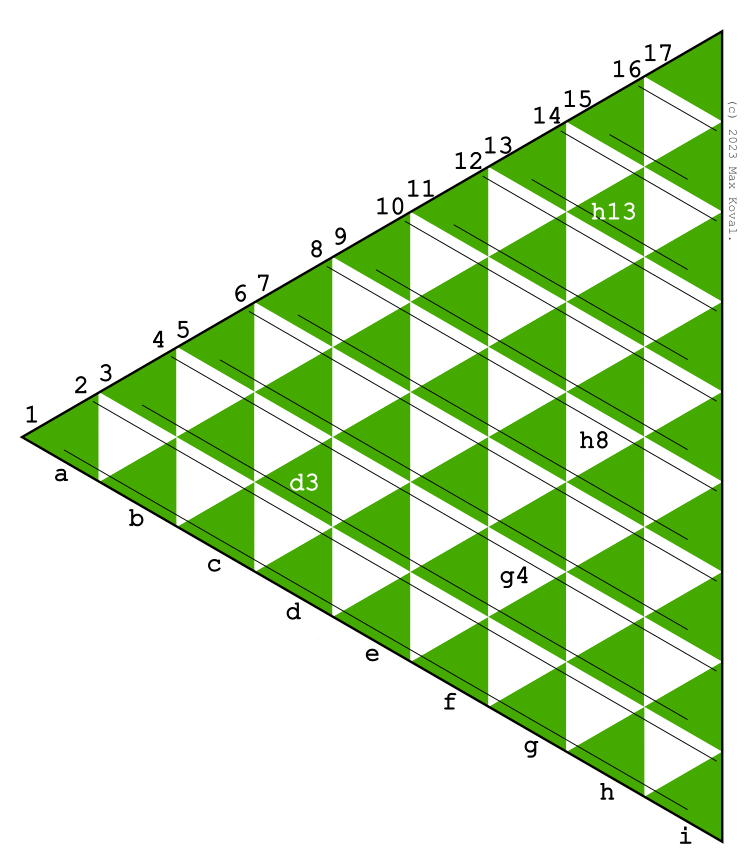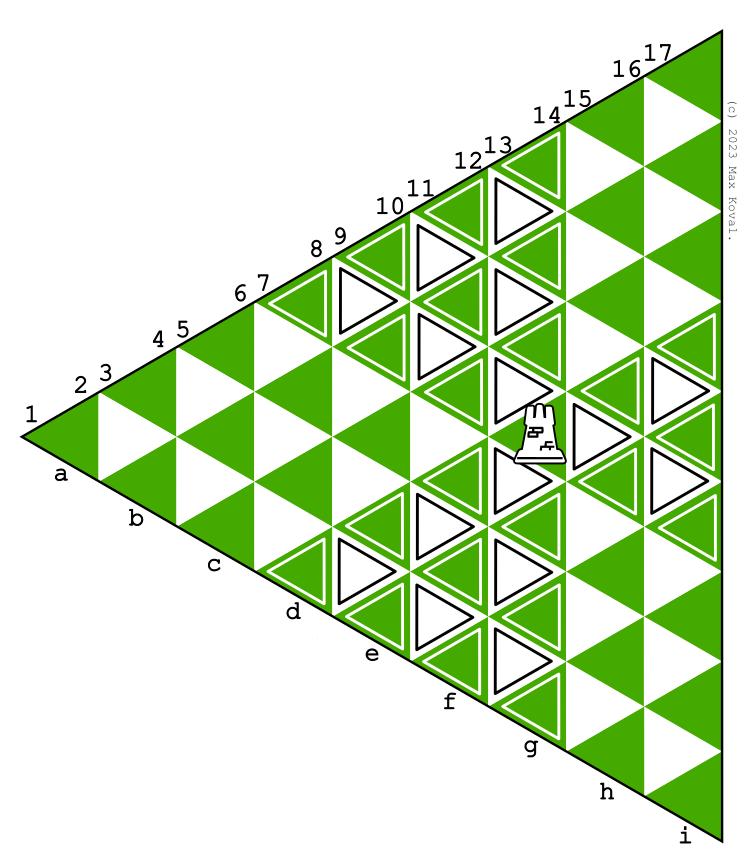Trigonal Chess
Trigonal chess is a 2-player trigonal or triangular chess variant invented by Max Koval in 2023. The game is played by 2 players on a triangle-shaped board made of 81 triangles and uses standard chess equipment.

My idea of this variant was to create chess on a board made of triangles and of a triangular shape that is symmetrical for both players while using standard chess equipment and similar positioning without modification of the chess rules.
The only new principle which is applied and seems to be natural for this board type is the new property of the sliding pieces (rook, bishop, and their derivatives). Instead of the condition where every cell is followed by the next one from the previous cells' most distant side (for the rook) or angle (for the bishop), a form of movement used in rectangular and hexagonal variants, and that is impossible on a triangular tiling, in this game, the sliding pieces move in alternating directions to avoid constant branching of their trajectory, which could result from a direct translation.
No trigonal variants known by me used the same principles equally for the rook and bishop and, in most cases, individually applied synthetic rules were proposed which resulted in unnatural ways of movement.
Most triangular variants, including perhaps the most known one George R. Dekle Sr., proposed an initial setup where an extra fairy piece is needed, which in my opinion is not natural for a game that can be supposed to be a direct translation. The hexagon-shaped board which was used there is also not suitable for a trigonal variant. Even the variants which proposed setups without fairy pieces, and included relatively natural movement rules, didn't allow symmetrical and fair starting positions for both players.
The proposed game suggests to solve these problems with the introduction of a chess-resembling opening setup, a triangle-shaped playing field as well as the rules naturally delivered from orthodox chess.
Setup

White: king h2; queen g1; bishop g2, h1; knight f1, i2; rook f2, i1; pawn f2, f1, g2, g1, h2,h 1, i2, i1.
Black: king h14; queen g13; bishop g12, h15; knight f11, i15; rook f10, i17; pawn f8, f9, g10, g11, h12, h13, i14, i15.
The way coordinates work is shown below:

Pieces
Rook
The rook moves an arbitrary number of spaces in any alternating orthogonal direction, always in a most distant side like a chess rook. This type of rook is used in a variety of other triangular variants.

Bishop
The bishop moves an arbitrary number of spaces in any alternating diagonal direction, always in a most distant side like a chess bishop. It shares the same logic with the rook's movement, but it wasn't introduced in other known triangular variants.


Queen
The queen moves like the rook and bishop combined.
King
The king moves like the queen, but in one cell in any direction only. Castlings in both directions are possible.
Knight
The knight's move can be defined as one step in an orthogonal direction, and then one step diagonally in an outward direction. As in standard chess, the knight jumps, and the piece that is jumped over is further not affected by it.

Pawn
The pawn can passively move one cell forward, or attack in all of three possible diagonal directions forward, also only by one cell.
If it is still on the 3d rank, it can move two cells passively forward (please note that it overlaps with one of its attacking moves).

Rules
With all the mentioned exceptions, other rules are the same as in orthodox chess.
Notes
There's a 'hard' variation of this game's movement rules where instead of alternating movement, a normal way is used with the only remark that a piece should always stay further from its initial cell (no round or parallel moves, etc).
Rook
The rook moves an arbitrary number of spaces in any orthogonal direction.

Bishop
The bishop moves an arbitrary number of spaces in any diagonal direction. On an empty board, the bishop is able to cover all the cells of its color. Normally, on a board with other pieces, the bishop's directions are somewhat limited, which makes the variant stable enough to be playable.

Queen.
The queen moves like the rook and bishop combined.
Other pieces remain unaffected.
 This 'user submitted' page is a collaboration between the posting user and the Chess Variant Pages. Registered contributors to the Chess Variant Pages have the ability to post their own works, subject to review and editing by the Chess Variant Pages Editorial Staff.
This 'user submitted' page is a collaboration between the posting user and the Chess Variant Pages. Registered contributors to the Chess Variant Pages have the ability to post their own works, subject to review and editing by the Chess Variant Pages Editorial Staff.
By Max Koval.
Web page created: 2023-03-18. Web page last updated: 2023-06-22